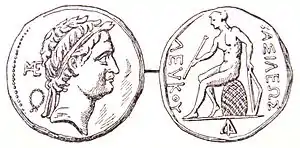| Seleucus IV Philopator | |
|---|---|
| Basileus | |
 Silver tetradrachm of Seleucus IV, minted in Ptolemais-Ake, featuring a portrait of Seleucus on the obverse. SC 1331a | |
| Basileus of the Seleucid Empire | |
| Reign | 3 July 187 – 3 September 175 BC |
| Predecessor | Antiochus III the Great |
| Successor | Antiochus |
| Born | c. 218 BC |
| Died | 3 September 175 BC (aged 42–43) |
| Spouse | Laodice IV |
| Issue | Antiochus Demetrius I Soter Laodice V |
| Dynasty | Seleucid |
| Father | Antiochus III the Great |
| Mother | Laodice III |
Seleucus IV Philopator[1] (Greek: Σέλευκος Φιλοπάτωρ; c. 218 – 3 September 175 BC),[2][3] ruler of the Hellenistic Seleucid Empire, reigned from 187 BC to 175 BC over a realm consisting of Syria (now including Cilicia and Judea), Mesopotamia, Babylonia and Nearer Iran (Media and Persia).
Biography
Birth and family
He was the second son and successor of Antiochus III the Great and Laodice III. He was made heir to his father after the death of his elder brother Antiochus the young king, in 193 BC.[4] Seleucus IV wed his sister Laodice IV, by whom he had three children: two sons Demetrius I Soter, Antiochus and a daughter Laodice V.
Seleucid conflict with Rome
During the prelude to the Roman-Seleucid War, Seleucus was put in charge of the re-established colony of Lysimacheia by his father.[5][6] Upon the outbreak of war, Seleucus commanded his own force, unsuccessfully besieging Pergamon,[7] and taking the city of Phocaea[8] before fighting in the Battle of Magnesia alongside his father.[9] After their defeat at Magnesia, Seleucus was made co-regent in 189 BC[10] and the Seleucids signed the Treaty of Apamea with Rome in 188 BC.[11] As part of the treaty, Seleucus oversaw the supply of grain and scouts to Roman and Pergamene forces during their campaign against the Galatians.[8]
Reign
In 187 BC, Antiochus died[11] after looting the Temple of Bel in Elymaïs[12] and Seleucus took over as Basileus. He renewed an alliance with the Achaean League,[12] and almost joined in Pharnaces I's invasion of Galatia, before reconsidering and turning back.[10][12] He also substituted his son Demetrius instead of his brother Antiochus IV as a hostage in Rome.[13]
Death
On September 3, 175 BC (137 SE), Seleucus was assassinated by Heliodorus, one of his leading bureaucrats. The ancient sources do not record a motive for this act; possibly it was simple lust for power, or possibly the sources misattributed the death to the one who gained the most from it.[14] Heliodorus took over as regent, ruling on behalf of Seleucus IV's young child Antiochus. Heliodorus's reign as regent was brief, however; months later, he was replaced by Antiochus IV with support from Pergamon.[13][10]
In the Judeo-Christian tradition

The book 2 Maccabees discusses Seleucus IV, a Jewish text later included as scripture by Christians. In 2 Maccabees 3, Seleucus IV sends out Heliodorus on a tax-collecting mission after hearing an inflated report of the Temple's wealth. Helidorus attempts to raid the treasury of the Second Temple in Jerusalem, but is repelled by angelic beings in a miracle.[15] The incident is also referred to obliquely in the Book of Daniel which states that Seleucus "will send out a tax collector to maintain the royal splendor";[16] the collector is also referred to as an "extortioner" (Jerusalem Bible) or an "exactor of tribute" (Revised Standard Version).
Other ancient accounts
In general, many (non-religious) ancient sources portray Seleucus IV as something of a weak ruler. Lester L. Grabbe cautions that this hostility may be unwarranted from historians who expected skilled kings to go to war. Seleucis IV appears to have run a fairly quiet period of rebuilding, but he managed relations with Rome astutely given the inferior position the Seleucid Empire found itself in after its defeat in the Roman–Seleucid War. A decade of peace would give the Seleucid Empire time to recover its strength.[17]
Ancestry
| Ancestors of Seleucus IV Philopator | ||||||||||||||||||||||||||||||||||||||||||||||||||||||||||||||||||||||||||||||||||||||||||||||||||||||||||||||||||||||||||||||||||||||||||||||||||||||||||||||||||||||||||||||||||||||||||||||||||||||||||||||||||||||||||||||||||||||||||||||||||||||||||||||||||||||||||||||||||||||||||||||||||||||||||||||||||||||||||||||||||||||||||||||||||||||||||||||||||||||||||||||||||||||||||||||||||||||||||||||||||||||||||||||||||||||||||||||||||||||||||||||||||||||||||||||||||||||||||||||||||||||||||||||||||||||||||||||||||||||||||||||||||||||||||||||||||||||||||||||||||||||||||||||||
|---|---|---|---|---|---|---|---|---|---|---|---|---|---|---|---|---|---|---|---|---|---|---|---|---|---|---|---|---|---|---|---|---|---|---|---|---|---|---|---|---|---|---|---|---|---|---|---|---|---|---|---|---|---|---|---|---|---|---|---|---|---|---|---|---|---|---|---|---|---|---|---|---|---|---|---|---|---|---|---|---|---|---|---|---|---|---|---|---|---|---|---|---|---|---|---|---|---|---|---|---|---|---|---|---|---|---|---|---|---|---|---|---|---|---|---|---|---|---|---|---|---|---|---|---|---|---|---|---|---|---|---|---|---|---|---|---|---|---|---|---|---|---|---|---|---|---|---|---|---|---|---|---|---|---|---|---|---|---|---|---|---|---|---|---|---|---|---|---|---|---|---|---|---|---|---|---|---|---|---|---|---|---|---|---|---|---|---|---|---|---|---|---|---|---|---|---|---|---|---|---|---|---|---|---|---|---|---|---|---|---|---|---|---|---|---|---|---|---|---|---|---|---|---|---|---|---|---|---|---|---|---|---|---|---|---|---|---|---|---|---|---|---|---|---|---|---|---|---|---|---|---|---|---|---|---|---|---|---|---|---|---|---|---|---|---|---|---|---|---|---|---|---|---|---|---|---|---|---|---|---|---|---|---|---|---|---|---|---|---|---|---|---|---|---|---|---|---|---|---|---|---|---|---|---|---|---|---|---|---|---|---|---|---|---|---|---|---|---|---|---|---|---|---|---|---|---|---|---|---|---|---|---|---|---|---|---|---|---|---|---|---|---|---|---|---|---|---|---|---|---|---|---|---|---|---|---|---|---|---|---|---|---|---|---|---|---|---|---|---|---|---|---|---|---|---|---|---|---|---|---|---|---|---|---|---|---|---|---|---|---|---|---|---|---|---|---|---|---|---|---|---|---|---|---|---|---|---|---|---|---|---|---|---|---|---|---|---|---|---|---|---|---|---|---|---|---|---|---|---|---|---|---|---|---|---|---|---|---|---|---|---|---|---|---|---|---|---|---|---|---|---|---|---|---|---|---|---|---|---|---|---|---|---|---|---|---|---|---|---|---|---|---|---|---|---|---|---|---|---|---|---|---|---|---|---|---|---|---|---|---|---|---|---|---|---|---|---|---|---|---|---|---|---|---|---|---|---|---|---|---|---|---|---|---|---|---|---|---|---|---|---|---|---|---|---|---|---|---|---|---|---|---|---|---|---|---|---|---|---|---|---|---|---|---|---|---|---|---|---|---|---|---|---|---|---|---|---|---|---|---|---|---|---|---|---|---|---|---|---|---|---|---|---|---|---|---|
| ||||||||||||||||||||||||||||||||||||||||||||||||||||||||||||||||||||||||||||||||||||||||||||||||||||||||||||||||||||||||||||||||||||||||||||||||||||||||||||||||||||||||||||||||||||||||||||||||||||||||||||||||||||||||||||||||||||||||||||||||||||||||||||||||||||||||||||||||||||||||||||||||||||||||||||||||||||||||||||||||||||||||||||||||||||||||||||||||||||||||||||||||||||||||||||||||||||||||||||||||||||||||||||||||||||||||||||||||||||||||||||||||||||||||||||||||||||||||||||||||||||||||||||||||||||||||||||||||||||||||||||||||||||||||||||||||||||||||||||||||||||||||||||||||
See also
References
- ↑ "Philopator — definition, examples, related words and more at Wordnik".
- ↑ "Seleucus IV Philopator". Livius.org.
- ↑ Encyclopædia Britannica, Vol. 20 (1973), p. 190
- ↑ Grainger 2015, p. 2–3.
- ↑ Livius, Titus. Ab Urbe Condita. Vol. 35.
- ↑ "Appian, The Syrian Wars 1 - Livius". www.livius.org. Retrieved 6 November 2020.
- ↑ "Appian, The Syrian Wars 6 - Livius". www.livius.org. Retrieved 6 November 2020.
- 1 2 Livius, Titus. Ab Urbe Condita. Vol. 37.
- ↑ "Appian, The Syrian Wars 7 - Livius". www.livius.org. Retrieved 6 November 2020.
- 1 2 3 Hornblower, Simon; Spawforth, Antony; Eidinow, Esther (2012). The Oxford classical dictionary. p. 1342. ISBN 978-0-19-954556-8. OCLC 779530090.
- 1 2 Hornblower, Simon; Spawforth, Antony; Eidinow, Esther (2012). The Oxford classical dictionary. p. 105. ISBN 978-0-19-954556-8. OCLC 779530090.
- 1 2 3 Siculus, Diodorus. Bibliotheca Historica. Vol. 29.10.15.
- 1 2 "Appian, The Syrian Wars 9 - Livius". www.livius.org. Retrieved 6 November 2020.
- ↑ Gera, Dov (1998). Judaea and Mediterranean Politics 219 to 161 B.C.E. Leiden: Brill. p. 110-113. ISBN 90-04-09441-5.
- ↑ Scolnic, Benjamin (2004). Alcimus, Enemy of the Maccabees. University Press America, Inc. p. 5. ISBN 0-7618-3044-8.
- ↑ Daniel 11:20: New International Version
- ↑ Grabbe, Lester L. (2008). A History of the Jews and Judaism in the Second Temple Period: The Coming of the Greeks: The Early Hellenistic Period (335–175 BCE). Library of Second Temple Studies. Vol. 68. T&T Clark. p. 319. ISBN 978-0-567-03396-3.
External links
- Seleucus IV Philopator entry in historical sourcebook by Mahlon H. Smith